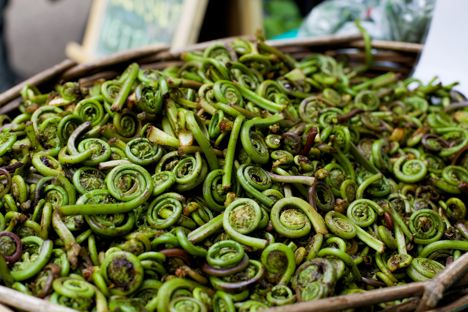
Canada: the land of plenty
Fiddleheads, chokecherries, mooseberries – Canada is home to some of the most jovially-named ingredients in the world. Discover some of the country’s unique herbs and plants and how native ingredients help shape the national cuisine.
Canada: the land of plenty
Fiddleheads, chokecherries, mooseberries – Canada is home to some of the most jovially-named ingredients in the world. Discover some of the country’s unique herbs and plants and how native ingredients help shape the national cuisine.
We’ve seen wild ingredients found in the British countryside break into the mainstream over the past few years – wild garlic, chanterelles and seaweed are now commonplace in our home kitchens, rather than being confined to specialist books and high-end restaurants. But in countries like Canada, where the majority of the country is taken up by stunning wild scenery, the natural larder has been celebrated in cooking for centuries.
Game is treated with the utmost respect in Canada. While Alberta is famous for its beef and peameal bacon is a national treasure, elk, caribou, venison and moose are popular across the country. Bison is held in particularly high regard, tasting similar to beef but with a richer, sweeter flavour. There’s also the ptarmigan, a grouse-like bird with a dark meat similar to mallard, prized by hunters and chefs alike.
Canada is home to all sorts of weird and wonderful berries, both grown commercially and found wild in the beautiful woods and forests of the country. Foraged herbs and vegetables also make an appearance on top-end restaurant menus whenever they’re in season, and the trends for preserving and pickling mean they can even be enjoyed year-round.
Here are some of Canada’s most unique ingredients, found in the country’s farmers’ markets the second they’re in season.
Chokecherries
Also known as black cherries, these fruits look more like elderberries than anything else, found hanging in dense clusters in the Canadian woodland throughout late summer and early autumn. With a unique, slightly bitter taste, they’re made into syrups, jams, vinegars and wine, to be enjoyed throughout the winter.
Fiddleheads
This beautiful vegetable is like Canada’s answer to asparagus, popping up in farmers’ markets across the country in the springtime. They’re the young shoots of certain ferns, still curled up and yet to burst open, with a vibrant green colour. Once steamed, they have a wonderful nutty flavour and subtle bitterness, and are often paired with other early spring vegetables such as wild garlic or morel mushrooms.
Mooseberries
Found growing on shrubs throughout Canada, these orange-red berries (also known as highbush cranberries) are similar to cranberries in flavour and are made into jellies, jams and sauces, usually served alongside game.
Saskatoon berries
Found growing on tall bushes throughout north west Canada, Saskatoon berries are a true Canadian treat, served wherever possible when in season. The city of Saskatoon, Saskatchewan, is named after the berry, and they’re often preserved in any way possible. Similar to a blueberry in both appearance and flavour, Saskatoons taste a little ‘wilder’, with hints of almonds and raspberry. They can be tough to find outside of Canada, as domestic demand exceeds supply, so if you see any for sale be sure to snap them up.


